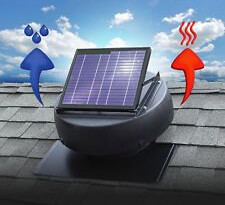Solar Attic Fan (303) 798-3880
Lowers attic temperature which reduces the load on the HVAC System.
 The most obvious reason for attic ventilation is to lower attic space temperature during the warmer months. Attic temperatures can exceed 160°F during hot summer days. Proper attic ventilation can reduce those temperatures by up to 50°F. No matter how much insulation is in the attic, heat can still transfer into adjacent living spaces. In fact, extra insulation can actually add to temperature increases because heat is trapped in the insulation. Proper ventilation evacuates this excess heat build-up. As the heat is exhausted, the work load of the air conditioning system is reduced, thereby saving energy and extending the life of the air conditioning system.
The most obvious reason for attic ventilation is to lower attic space temperature during the warmer months. Attic temperatures can exceed 160°F during hot summer days. Proper attic ventilation can reduce those temperatures by up to 50°F. No matter how much insulation is in the attic, heat can still transfer into adjacent living spaces. In fact, extra insulation can actually add to temperature increases because heat is trapped in the insulation. Proper ventilation evacuates this excess heat build-up. As the heat is exhausted, the work load of the air conditioning system is reduced, thereby saving energy and extending the life of the air conditioning system.
Extends the life of the roofing materials.
Though asphalt shingles are designed to take the abuse of the sun for many years, they are subjected to greater temperatures when the roof decking is allowed to overheat, which is just what happens in an under ventilated attic.
In the cooler months, moisture is the most serious concern. Even with the use of vapor barriers to keep moisture from entering the attic, there are air leaks around ceiling light fixtures, bathroom exhaust fans that allow unwanted moisture into the attic. Moisture condensing on the framing members and the inside of the roof deck can lead to the growth of mold, mildew and rot in the roof deck and framing. A good indicator of moisture problem is rusty roof nails sticking through the roof deck.
Asphalt shingle manufacturers warranties require proper attic ventilation. Attic ventilation is required in cold environments – it evacuates the warm moist air that heat sources produce. Hot moist air lingering in the attic spaces can condense on the underside of the roof sheathing and rot it out, and also causes mold to develop on the interior walls. Cold air in the attic space will not affect the temperature in the adjacent living spaces if properly insulated. Good ventilation helps prevent ice dams, which begin to form when warm air in the attic melts the snow from beneath and creates runoff that refreezes on the colder eaves.
